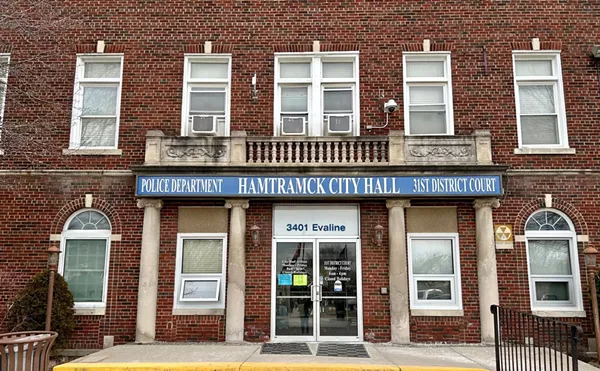
Audio By Carbonatix
[
{
"name": "GPT - Leaderboard - Inline - Content",
"component": "35519556",
"insertPoint": "5th",
"startingPoint": "3",
"requiredCountToDisplay": "3",
"maxInsertions": 100,
"adList": [
{
"adPreset": "LeaderboardInline"
}
]
}
]
Oakland County has bowling alleys where Joe Six Pack rolls, mansions on the waterfront where the wealthy live and play, and plenty of middle-class neighborhoods where white- and blue-collar alike worry about their house payments and job security.
Among its 61 cities and townships, it has plenty of strip-mall sprawl but also cozy downtowns with art galleries, coffee shops and destination restaurants. It has pockets of poverty, homes in foreclosure and people who are unemployed in Michigan's nation-leading economic mess.
Once a white bastion, the county now nearly mirrors the nation in terms of diversity. With growing numbers of minorities and immigrants among its more than 1.2 million people, the county has gone from 90 percent white in 1990 to 79 percent in 2006, according to the U.S. Census Bureau. During the same time, the percentage of whites nationwide fell from 80 percent to 74 percent. In terms of age, about 12 percent of Oakland County's population is 65 or older, which matches the national figure.
The one big difference between the O.C. and the rest of the nation regards income. According to the 2006 American Community Survey, Oakland's median household income was $66,483, nearly 38 percent higher than the national average of $48,451.
How all of those factors translate to ballot decisions are what Oakland County voters, political observers and even the candidates themselves are wondering this fall. How will residents of this 910-square-mile county vote Nov. 4 — for Illinois Democratic Sen. Barack Obama or Arizona Republican Sen. John McCain? Will the county hold to its Republican roots or continue recent Democratic trends in congressional and countywide elections?
Twenty years ago, Oakland County was an unassailable Republican stronghold, and that is still true in its more rural northern third. But people from its southern, more progressive suburbs are creeping north, with more middle-class African-Americans and other ethnic and racial groups altering the county's voting patterns.
The result is an electorate with a record-high 915,511 registered voters this year that is less partisan and more unpredictable than it once was.
"Oakland County voters will vote for the person they think is going to do the best job, not necessarily ideologically," says Kurt Metzger, director of research with the United Way of Southeastern Michigan.
In 1996, the county —for the first time in more than 75 years — went for the Democratic presidential candidate, Bill Clinton, and has gone "blue" in that race every four years since then. The County Commission has slid from a strong Republican majority to its current 13-12 split, with the GOP holding just a one-vote advantage as southern suburbs have increasingly elected Democratic commissioners.
But in between those governmental levels, three of the four congressmen representing parts of the county are Republican as are all of the countywide elected officials, including longtime County Executive L. Brooks Patterson, who is seeking his fifth term in office. Of the mayors or township supervisors who list a party, most are Republican.
"It means the voters are willing to give somebody a chance and listen to them, rather than hit the Republican button or Democrat button," says Dennis Cowan, the chair of Oakland's Republican Party. "It's not all just one-party dominance."
Increasing diversity
Ask anyone how Oakland County has changed in the last two decades and you'll get a quick answer: The area's population, economic situation and political choices are all becoming more diverse.
Since 2000, according to the U.S. Census, the numbers of African-Americans, Asians and Hispanics living in Oakland County have grown while the population of whites has fallen. Southfield is now a majority African-American suburb. The Chaldean community is estimated at 68,000. The county's foreign-born population has grown from about 119,000 in 2000 to about 142,000 in 2006, according to the census bureau's American Community Survey.
Economically, the county is generally wealthy and educated. Per capita income is 42 percent higher than the national average — $35,883 to $25,267. About 42 percent of Oakland County residents have a bachelor's degree or higher, a 57 percent higher rate than the country as a whole.
But in a nation where the disparity between rich and poor has grown dramatically during the past few decades, parts of Oakland County provide a poignant snapshot of the divide. According to census data, poverty exists. Nearly 7 percent of the county's residents have incomes below the poverty level, and, in Pontiac, that rate rises to a quarter of the residents, nearly double the national rate.
Jason Booza, a demographer at Wayne State University's School of Medicine, analyzed the 2000 U.S. Census tract data for Oakland County's median household incomes and found six of the 10 poorest areas were located in Pontiac. In the southeast corner of the city, one of the county's poorest neighborhood literally touches one of the wealthiest, a tract in Bloomfield Township where an average household earned about $146,000 annually.
In Oakland County, the five lowest median household incomes by tract, Booza says, average less than $18,000 annually, while the five highest average about $155,685.
"Oakland County tends to have higher incomes, higher levels of education and more knowledge-based employment. It's very different than the rest of the region," Metzger says. Higher incomes often mean a region is more likely to be Republican, but not necessarily so in Oakland County. "It tends to have a little broader view, but that's also what drives it a little more liberal on some of the social issues and tending to go more Democratic," says Metzger, who lives in Huntington Woods.
Politically, the county has voted Democratic in the last two gubernatorial elections, supporting Gov. Jennifer Granholm over the socially conservative Dick DeVos 54 percent to 45 percent in 2006. In the last two presidential races, just one percentage point gave both John Kerry and Al Gore the county instead of George W. Bush in 2004 and 2000.
Among the voters in some of those races were Prasanna Vengadam and Martin Manna, and they have ideas about how their respective communities will vote in November.
It's karma, stupid
A native of India, Vengadam came to the United States in 1985 for graduate school in Boston. She met her husband there, and when Ford Motor Co. transferred him, the couple moved to Troy where they are raising a son.
Troy is home to the highest number of Indians in southeast Michigan, according to a 2002 Wayne State University study. About 40,000 Indians or Indian-Americans lived in the tri-county area in 2000, according to the U.S. Census, a figure that grew to about 58,000 by last year.
Vengadam and her family are among the estimated 30,000 Indian-Americans now living in Oakland County. Many are doctors and engineers, she says, and their high incomes mean they often lean Republican. But the Indian community is itself very diverse, and its members also vote for candidates they like as individuals as well. She predicts Obama will carry the Indian vote in Oakland County.
"I keep thinking, what does it mean to be Asian ... in the context of the election," says Vengadam, who works as part-time faculty at Wayne State University teaching public speaking. "I kind of wonder, what is this going to mean to the Indian community?"
Indians began obtaining visas for the United States after President Lyndon B. Johnson signed the Immigration and Nationality Act in 1965 which allowed more immigrants, mainly professionals, to come here from non-Western nations, including Asian and Latin American countries.
"Initially Indians came in as the minority group and they tended to think probably more Democratic because of feeling not really quite in tune with the message of the heartland of America," Vengadam says. But that tended to change as the population became more established and obtained higher-paying jobs. Look at their incomes now, she says, and "you can tell they may vote Republican." People with higher incomes tend to vote Republican, research shows.
But according to the National Asian American Survey, a joint project of four universities in California and New Jersey, Indian-American voters in general support Obama by more than a 3-to-1 ratio. The same survey found Asian-American voters listed the economy as the election's top priority followed by the war in Iraq.
Vengadam agrees with that finding based on her personal observations and conversations. In Oakland County, she says, Indians like other groups come together around religious centers where the morality of the war is often discussed.
"A lot of Indians are absolutely ticked off about the war," she says. "As a culture that believes in karma, we believe this is going to come back to haunt us a thousand times."
Homefront Iraq
The wars in Iraq and Afghanistan and their management are a chief concern of Oakland County's Chaldean community, says Manna, the executive director of the Chaldean American Chamber of Commerce. With a membership of more than 1,000 businesses, the chamber represents and promotes economic opportunities for the Chaldean community as well as other Christian, Aramaic-speaking people — Assyrians and Syriacs.
An estimated 113,000 Chaldeans live in metro Detroit, the largest such community outside of Iraq. About 60 percent of them reside in Oakland County, where a majority of households own at least one business. The chamber estimates about 6,000 businesses in the state are owned by Chaldeans. "If you were to remove the Chaldean community from Michigan, it would be a big burden," Manna says.
High involvement in business moves economic issues — including taxes and health insurance policies —front and center for Chaldean-American voters, Manna says.
But failed efforts in Iraq — including, Manna contends, continued violence against Christians whom he says the United States has failed to protect — are greatly influencing these voters' decisions this year. With strong ties to family members who remain in Iraq, he says, the issue is particularly personal.
"The United States would never want to admit that this war is wiping out the oldest Christian community in the world," Manna says. "There's an organized genocide going on."
The disappointment in the failed protection of Christian communities in the Middle East has Manna and other voters less inclined to vote a straight Republican ticket this year, he predicts.
Manna himself has given money to Republican and Democratic candidates, including McCain and Democratic U.S. Sen. Carl Levin, but won't say how he is voting for president in November.
In September, a Zogby International poll commissioned by the Arab American Institute found Arab-Americans nationwide favored Obama 54 percent to 33 percent over McCain. Voters listed jobs and the economy as the more important issue followed by the war in Iraq and other foreign policy concerns.
The Obama bump
With polls showing Obama also leading among Oakland County voters 48 percent to 42 percent, according to a Mitchell Research & Communications survey released earlier this month, Democratic candidates in other races are hoping to get a bump from the Illinois senator's popularity. Pundit Bill Ballenger says that's most likely to happen in the 9th Congressional District, where Democrat Gary Peters, who formerly served as a state senator and then Michigan's lottery commissioner, is challenging longtime incumbent Rep. Joe Knollenberg (R-Bloomfield Township).
The Mitchell poll found the two candidates tied with 43 percent of the vote.
Obama has appeared with Peters at a Troy rally and the would-be congressman introduced the would-be president at Detroit's Labor Day event.
Knollenberg was first elected to Congress in 1992. The district claims a wide slice of Oakland County, from Farmington Hills to Oakland Township and Waterford to Royal Oak Township.
Peters, 49, is helped not only by Oakland's willingness to consider voting for Democrats but also by other national factors, says Ballenger, who edits the political newsletter Inside Michigan Politics.
"You've got an unpopular Republican president in the White House. Anything like that is going to have a negative impact on the Republican, whoever it is," says Ballenger, who says the poor economy and McCain's abandonment of Michigan are also important factors in the race. "The fact of the matter is, it ain't helping Knollenberg."
Peters says the increasing diversity of Oakland County is reflected in his district, and he says voters are willing to be "ticket-splitters," voting for candidates from more than one party in a single election.
"People are open to change," he says. "If you're a fiscal conservative, well, Republicans have been far from fiscally conservative. On social issues, folks here tend to be more progressive."
But Knollenberg, along with Thaddeus McCotter — who represents the southwest corner of Oakland County and part of Wayne County in Congress — should have widespread support from the Chaldean community, Manna says, because of their Middle East policies.
Peters' family has lived in Oakland County since the 1840s, when they farmed in Rochester. His wife, Colleen, grew up in Waterford, and he points to his mother, a French citizen and World War II bride, as helping him understand the issues today's immigrants face. Peters earned a bachelor's degree from Alma College, a master of business administration from University of Detroit Mercy and a law degree from Wayne State.
He worked in financial services for 20 years and as a lieutenant commander in the U.S. Navy before serving in the state Senate and then as lottery commissioner. He now teaches at Central Michigan University. His two daughters are in middle school, and his son, who graduated from college last year, works as an accountant in Detroit. His father, now in his 90s, lives in Rochester.
"We're facing all the challenges that most families in Oakland County are facing right now," he says. "I believe that's the type of person you want representing you in Washington."
Knollenberg, 74, for his part, is from a family of farmers in central Illinois. He earned a bachelor's of social science from Eastern Michigan before serving in the U.S. Army. After his tour of duty, he began selling insurance for New York Life, eventually transferring to Detroit with the company. He formed his own agency in the late 1980s, before running for Congress in 1992. He's now ranking member on the House Appropriations Subcommittee on Transportation and Housing and Urban Development and a member of the Appropriations Subcommittee on Foreign Operations.
"I'm ready to keep fighting for you," Knollenberg told a Rochester audience last week. "I have the right vision and the background to deliver the results Oakland County families need."
But Peters has a great chance at the seat if the voting trend continues.
In 2002, when the current district boundaries took effect, Knollenberg won with 58 percent of the vote, and in 2004, he matched that majority. But in 2006, Knollenberg's support slipped to 52 percent against an inexperienced opponent, Nancy Skinner, whose greatest political claim to fame was losing in the 2004 Illinois U.S. Senate primary to Obama.
Though Knollenberg has more cash on hand, Peters is better financed than the past challengers in the district. According to the Center for Responsive Politics, an independent, nonpartisan Washington, D.C.-based organization that tracks political money and its effect on elections, Peters and Knollenberg have raised much more money than other Michigan congressional candidates this year.
Peters reports more than 4,000 individual donors — 10 times, he says, the number Skinner had in 2006 — and had raised about $1.9 million by last week. Skinner, in contrast, had about $400,000 for her entire campaign.
Still, Knollenberg had raised $3.1 million and, as the campaign enters its final weeks has considerably more money left — $2 million compared to $500,000 for Peters, according to campaign finance reports. Knollenberg says he intends to spend it on advertising in the final weeks of the campaign.
But Peters is getting help from the national Democratic Congressional Campaign Committee which has financed commercials. Other political groups — the Patriot Majority Midwest and the Humane Society Legislative Fund — have placed commercials supporting him.
For Knollenberg, real estate and credit union political action committees have paid for commercials, says Nate Bailey, campaign spokesman. That's filling some of the gap left when the National Republican Congressional Committee scaled back its efforts on Knollenberg's behalf, Bailey says.
The two candidates met last week to debate at Oakland University, where they were joined by fellow candidates Jack Kevorkian, who has no political party affiliation, and the Green Party's Douglas Campbell. (Libertarian Adam Goodman did not attend.)
Echoing their parties' respective presidential candidates, Knollenberg and Peters offer stark differences on tax policy and the war in Iraq when questioned about their ideas.
"The worst thing we could do is raise taxes," Knollenberg says. "If they take your money and redistribute it, you won't get it back."
But Peters favors a middle-class tax break and an increase in corporate taxes, especially for companies that have sent jobs overseas, in efforts to help address the economic crises.
"Our priority has to be, first and foremost, to give breaks to middle-income earners," Peters says. "I think we also need to take a look at our corporate taxes. ... Right now there are tax breaks that are given to corporations that ship jobs overseas. To me, that doesn't make any sense."
Regarding the Middle East, Peters favors a troop pullout from Iraq. "It needs to be done in a safe and responsible way. Let's be clear that it needs to be done now," he says. He also advocates for more attention to Afghanistan. "Some of the troops need to be redirected into Afghanistan," he says. "We also need to look at winning the hearts and minds of the Afghan people."
In response to the same question about military policy in that region, Knollenberg's assertion that "the surge has worked," was met by laughter in the debate audience. But he says the situation in Iraq has improved, especially as measured by the situation between different Iraqi religious groups. "They have come together in Iraq. They're not killing each other. That was the problem before," he says.
Passion for change
Some of Knollenberg's commercials have featured him with the popular county executive Patterson.
"They work closely on many economic development issues," Bailey says. "Joe and Brooks have a very sophisticated relationship."
Patterson himself is facing an interesting and, many say, credible if not likely successful challenge this fall from Southfield Mayor Brenda Lawrence.
Elected the suburb's first African-American and first female mayor in 2001 and now serving a second term, Lawrence is representative, in part, of the political impact of Oakland County's growing diversity. She doesn't offer to compare herself with Barack Obama, but asking if there are similarities between them gets this answer:
"With myself and Barack Obama, America and Oakland County can see that a person can be passionate, they can be educated, they can garner experience and leadership and be effective. They can be that even if they're Asian or African or from the east side of Detroit," she says. "America is being forced to look at what you bring to the table."
Lawrence grew up in Detroit and earned a bachelor's degree in public administration from Central Michigan University. She worked for the U.S. Postal Service and served on the Southfield school board from 1992 to 1996 and the City Council from 1991 to 2001.
She's campaigning on a platform of change, naturally, but cites a need to build regionalism, maintain the county's high quality of life and continue to maximize economic development.
"His tenure is one that's all business-related," she says of Patterson. "We need leadership that understands there's a connection between Wall Street and Main Street."
Lawrence and Patterson met last week in a debate that's being broadcast on Oakland County cable channels and can be viewed online at cmntv.org. There Patterson criticized her plans for mass transit as irresponsible to taxpayers who would pay for the system's installation and said his administration has paved the way for hundreds of millions of dollars in investments in Oakland County.
"We're getting huge dividends," he says. "I look at my track record and I'm proud of it."
But for all the attention to economic development from both candidates, Lawrence says the attention she'll get from voters is for a simple reason.
"I think this race is built on the passion for change," she says.
While Lawrence will likely stay in her mayoral post instead of taking the county executive position, Ballenger predicts that voter sentiment she describes will show up in other races.
"I just think there's a slow, seeping Democratic tide in the county, and they could make some breakthroughs this year," Ballenger says. "Obama could easily carry Oakland County. [Sen. Carl] Levin certainly will carry Oakland County."
He doesn't predict Patterson will lose his race this time, but does say the future countywide political landscape could look quite different for his GOP.
"All of a sudden, two years down the road, Republicans are going to be looking at Democrats running for everything and who are expecting to win," he says.
Sandra Svoboda is a Metro Times staff writer. Send comments to ssvoboda@metrotimes.com




